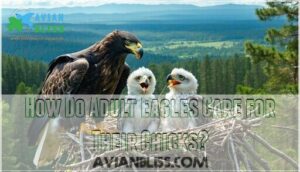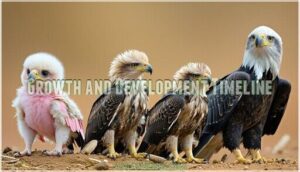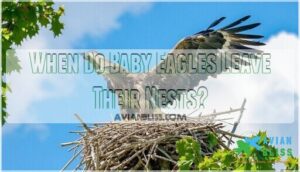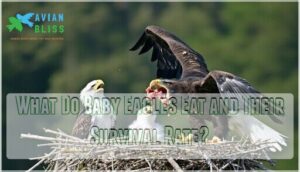This site is supported by our readers. We may earn a commission, at no cost to you, if you purchase through links.
 You’ll find that a baby eagle, called an eaglet, hatches as a tiny 3-ounce chick covered in fluffy gray down feathers.
You’ll find that a baby eagle, called an eaglet, hatches as a tiny 3-ounce chick covered in fluffy gray down feathers.
These remarkable raptors can’t regulate their own body temperature initially, so they depend entirely on their parents for warmth, protection, and food.
During their first few weeks, eaglets grow at an astonishing rate, doubling their weight weekly while developing the strength needed for flight.
Most species fledge between 10-14 weeks, though they’ll stick around the nest area for several more months learning essential hunting skills.
The transformation from helpless hatchling to soaring predator reveals nature’s most impressive developmental strategies.
Table Of Contents
- Key Takeaways
- What is a Baby Eagle’s Lifecycle?
- How Do Adult Eagles Care for Their Chicks?
- What Do Juvenile Eagles Look Like?
- What is a Baby Eagle Called?
- How Long Do Baby Eagles Stay With Their Parents?
- How Big and How Much Do Baby Eagles Weigh?
- How Long Do Baby Eagles Take to Grow?
- When Do Baby Eagles Leave Their Nests?
- What Do Baby Eagles Eat and Their Survival Rate?
- Frequently Asked Questions (FAQs)
- What is a baby eagle called?
- What do you know about a baby eagle?
- Do Baby Eagles Fly?
- What do Baby Eaglets look like?
- Is a baby eagle a Phoenix?
- How do you identify a baby eagle?
- What does a baby eagle look like?
- What are the baby animals of the eagle?
- Is the Jericho 941 a baby eagle?
- Is a Desert Eagle legal?
- Conclusion
Key Takeaways
- You’ll watch eaglets grow from helpless 3-ounce hatchlings to powerful predators in just 10-14 weeks through rapid weight gain and feather development.
- You’ll need to understand that eaglets depend entirely on their parents for food, warmth, and protection, with adults feeding them raw meat up to 8 times daily.
- You’ll recognize juvenile eagles by their distinctive mottled brown and white plumage that’s completely different from adult eagles’ crisp coloring.
- You’ll find that eaglets don’t achieve true independence until several months after fledging, as they must master essential hunting and survival skills under parental guidance.
What is a Baby Eagle’s Lifecycle?
You’ll witness an amazing transformation as baby eagles progress through distinct developmental stages from helpless hatchlings to powerful fledglings.
From fragile hatchlings to soaring fledglings, baby eagles showcase nature’s most remarkable transformation.
The eaglet lifecycle spans approximately 10-14 weeks in the nest, followed by months of learning essential survival skills under parental guidance.
Nesting Period and Clutch Size
Eagles break free from their shells to begin an extraordinary journey through nature’s most demanding nursery.
Eagle nest construction spans 1-3 months, with pairs returning to traditional sites annually.
Their reproductive strategy includes:
- Nest Size – Platforms reaching 9 feet wide and 16 feet deep
- Clutch Limits – Typically 1-3 eggs per breeding season
- Egg Laying – Intervals of 2-4 days between each egg
- Nesting Materials – Sticks, grass, and soft linings for eaglet care
The female eagle’s egg laying process is essential for the survival of the eaglets.
Incubation and Fledging Period
After eagle incubation lasting 35 days, you’ll witness chicks emerging with their specialized egg tooth.
The fledging time spans 8-14 weeks, during which eaglet care intensifies in the secure nest environment.
Nest safety becomes paramount as parents guard their developing eagle chick vigilantly.
Eagle fledging marks freedom’s approach, with nest building quality directly impacting fledge success rates during this critical developmental window.
Independence and Growth
Watching eaglets master independence becomes a thrilling journey through the juvenile phase.
After fledging, these young raptors set out on intensive flight training, strengthening wing muscles through persistent practice.
During this critical independence timeline, parents gradually reduce food provision, encouraging self-reliance.
The eagle development process accelerates as juveniles perfect hunting techniques, transforming from dependent chicks into skilled aerial predators within months of leaving the nest.
How Do Adult Eagles Care for Their Chicks?
You’ll witness remarkable parental dedication when observing eagle families, as both parents work tirelessly to feed, protect, and teach their vulnerable chicks.
Adult eagles demonstrate sophisticated caregiving behaviors that guarantee their eaglets develop the skills necessary for survival in the wild.
Feeding Process and Diet
Parent eagles deliver raw meat directly to their chicks’ beaks, tearing prey into manageable pieces.
This feeding schedule involves 1-8 daily meals, with parental provision prioritizing larger eaglets.
Carnivorous eaglets store excess animal protein in their crop for food storage.
Unlike many birds, eagles don’t use regurgitation – they provide fresh chunks.
This eagle diet and eagle feeding method helps develop hunting skills essential for survival.
The eaglets’ diet consists of various food sources, including those found in eagle food chains.
Parental Care in The First Few Months
Beyond feeding schedules, you’ll witness remarkable eagle parental care during those vital first months.
Both parents take turns brooding their chicks, maintaining ideal body temperature through constant contact.
Eagle nesting habits include fierce parental defense – adults will aggressively chase away threats while camouflaging the nest location.
During chick growth phases, parents continuously reinforce nest structures and prepare for fledging prep by encouraging wing exercises.
Learning to Hunt and Fly
After mastering basic feeding, young eagles enter their flight school phase.
Parents become their aerial instructors, teaching critical survival skills:
- Wing Development begins with strengthening exercises as eaglets practice flapping motions in the nest
- Flight Lessons progress from short hops to guided gliding sessions with parental supervision
- Hunting Techniques develop through observation as adults demonstrate aerial maneuvers and prey capture methods
These fledging techniques prepare eaglets for independent living.
What Do Juvenile Eagles Look Like?
You’ll instantly recognize juvenile eagles by their distinctive mottled brown and white plumage that looks nothing like the iconic adult bald eagle’s crisp coloring.
Juvenile eagles sport a patchwork of dark feathers and white streaks, blending perfectly into their wild surroundings.
These young birds sport a patchwork of dark brown feathers mixed with white streaks and spots, creating a camouflaged appearance that helps them blend into their surroundings during their vulnerable early years.
Plumage Descriptions
Baby eagle feathers transform dramatically from hatching to fledging.
Eaglets start with soft natal down that gradually gives way to juvenile feathers.
Their downy white feathers provide warmth while brown and black flight feathers emerge around week five, creating their distinctive mottled appearance.
| Age Stage | Feather Type | Color Pattern |
|---|---|---|
| Hatching | Natal Down | White/Gray Fluffy |
| 3-5 Weeks | Downy Plumage | Gray Wooly Texture |
| 6-10 Weeks | Juvenile Feathers | Brown/Black Mottled |
| Adult | Eagle Plumage | Dark Brown/White Head |
The transformation of baby eagle feathers is a critical aspect of their development, marking significant stages from hatching to adulthood.
Development and Mottled Plumage
Juvenile eagles undergo fascinating plumage change during their first year. Their downy coats start white or gray, then develop mottled patterns as eagle feathers emerge around day 27.
During the fledgling stage, eagle development creates distinctive speckled appearances:
- Dark brown base with white flecking on underwings
- Irregular speckled patterns unlike golden eagles’ solid patches
- Unique tail bands varying between individual baby eagles
- "Mud-spattered" eagle plumage on flight feathers
- Variable mottling making each eaglet distinct
This beak development period showcases nature’s artistic variation.
Transition to Adult Plumage
The molt process marks when juvenile eagles shed their mottled feathers for striking adult colors.
Feather growth accelerates as color shift begins around four years old.
This plumage change represents the final stage of juvenile development, transforming eagles into powerful hunters.
- Eagle growth stages progress through multiple bird plumage phases over several years
- Molt process occurs systematically, replacing old feathers with vibrant adult coloration
- Eagle chick development culminates when birds achieve their iconic white head and tail
- Eagle maturity coincides with reproductive readiness and territorial behavior establishment
Understanding the baby bald eagles development is essential for conservation efforts.
What is a Baby Eagle Called?
You’ve probably wondered what to call those adorable fluffy baby birds perched high in eagle nests.
Baby eagles are called eaglets, a term that distinguishes these vulnerable chicks from their powerful adult counterparts who rule the skies with impressive wingspans and razor-sharp talons.
Naming Convention
Young eagles earn their eaglet title from Old French "aiglet," meaning little eagle.
This baby eagle term dominates scientific literature and birdwatching communities.
You’ll encounter variations like eagle chick or eagle fledglings, but eaglet remains the standard bird title.
These eagle monikers reflect the species’ regal status, with species labels emphasizing their majestic heritage from hatching onward.
Eaglet Vs. Adult Eagle
Spotting the differences between eaglets and adult eagles reveals nature’s transformation process.
Eagle chick comparison shows dramatic feather growth patterns, from fluffy down to sleek plumage.
Baby eagles lack the iconic white head and yellow beak development that defines mature birds.
Wing span doubles during eagle growth, while nesting habits shift from dependency to independence under eagle parents’ guidance.
Folklore and Symbolism
Eagle mythology weaves through cultures worldwide, where baby eagles represent rebirth and untapped potential.
These spiritual associations connect eaglets to divine messengers and transformation stories. Their symbolic meanings encompass hope, growth, and emerging strength.
- Rebirth Symbolism: Eaglets represent new life cycles and fresh beginnings in Native American traditions
- Divine Connection: Many cultures view baby eagles as messengers between earthly and spiritual domains
- Transformation Power: Legendary stories describe eaglets growing into mighty protectors and guides
- Hope Embodiment: Eagle cultural significance often centers on eaglets as symbols of future prosperity
- Spiritual Awakening: Eagle folklore depicts young eagles discovering their true calling and inner strength
How Long Do Baby Eagles Stay With Their Parents?
You’ll want to know that baby eagles stay with their parents for different lengths of time depending on the species and individual circumstances.
The parental bond doesn’t end abruptly when eaglets fledge—instead, it’s a gradual phase that can last months or even years as young eagles learn essential survival skills.
Duration of Parental Care
Beginning after hatching, baby eagles require approximately 4-5 months of intensive parental guidance before achieving independence.
The nesting period spans 10-12 weeks of constant care, followed by 4-10 weeks of post-fledging supervision.
Eagle dependency decreases gradually as parents teach essential survival skills.
This extended care duration guarantees successful eagle parental investment in their offspring’s future.
Transition to Independence
As the fledging process nears completion, eaglets must master independent living skills that’ll determine their survival success.
This Independence Stage involves four critical developments:
- Flight Training becomes increasingly sophisticated as wing strength improves
- Hunting Skills develop through observational learning and trial-and-error practice
- Nest Departure timing depends on environmental conditions and food availability
- Eagle Juvenile Independence emerges gradually through reduced postfledging care from parents
The developments are crucial for the eaglets’ survival and success in the wild.
Relationship With Parents
After eight weeks of developing flight skills, you’ll observe parental bonding intensify between eagle parents and their young.
The eagle chick practices independence within safe territory boundaries, with parental protection ensuring survival.
The family dynamics shift as eagle guardians teach advanced hunting techniques while maintaining protective watch.
This nesting behavior period strengthens lifelong connections before full separation occurs.
How Big and How Much Do Baby Eagles Weigh?
When you’re curious about baby eagle size, you’ll find that newly hatched eaglets are surprisingly small and vulnerable.
These tiny raptors weigh just 3-5 ounces at birth and measure only 4-5 inches tall, but they’ll experience rapid growth that transforms them into powerful predators within months, becoming powerful predators.
Size and Weight at Birth
When you see a newborn eaglet at birth weight, you’re looking at nature’s smallest future predator. These tiny hatchling growth champions weigh just 100-115 grams (3.5-4 ounces) and measure only 4-5 inches tall – that’s smaller than your coffee mug!
Newborn eagles start their journey with these remarkable characteristics:
- Eagle chick dimensions: 10-13cm height, roughly the size of a tennis ball
- Eagle weight at hatching: equivalent to a stick of butter
- Eagle size comparison: fits comfortably in your palm
- Pink skin covered by thin gray natal down for insulation
- Proportionally large beak and feet ready for fledgling development
To accurately measure an eagle’s weight, one must consider the eagle weight scale.
Baby eagles may seem fragile, but they’re built for rapid transformation into apex predators.
Growth and Development
Eaglets experience explosive Eagle Development during their first months.
You’ll observe rapid Muscle Gain and Skeletal Maturity occurring within 10-14 weeks.
Feather Growth accelerates dramatically—eagle chicks evolve from fluffy down to juvenile plumage by eight weeks.
Eagle Growth Rates peak at one pound weekly, with Eagle Developmental Milestones including wing exercises at ten weeks, preparing them for the Eagle Fledging Process ahead.
Comparison With Adult Eagles
When a baby eagle hatches, it weighs just 3-4 ounces compared to adult eagles weighing 6.5-14 pounds.
By 10-12 weeks, eaglets reach nearly full Eagle Size with comparable Wing Span, though Feather Growth and Beak Shape changes continue.
Maturity Rate spans 4-5 years before achieving complete adult plumage, making the eagle juvenile stage distinctly different from the eagle adult stage despite similar physical dimensions.
How Long Do Baby Eagles Take to Grow?
You’ll discover that eagle growth follows a precise timeline from helpless hatchling to powerful predator.
Baby eagles reach skeletal maturity and fledge within 10-14 weeks, though their journey to full adult plumage can take up to 4-8 years depending on the species, which is a significant factor in their development into a powerful predator.
Growth and Development Timeline
Witness remarkable eagle development unfold through distinct growth stages.
These powerful raptors transform rapidly from helpless hatchlings to soaring predators through precise biological programming.
- First Week: Pink skin develops thick natal down, eyes open, egg tooth disappears
- Weeks 2-4: Thermal down replaces natal down, feather growth begins on wings/shoulders
- Weeks 5-10: Juvenile feathers emerge, skeletal maturity approaches, wing flapping starts
- 10-14 Weeks: Fledging process initiates as eagle chicks achieve flight readiness
Factors Affecting Growth
Several key factors powerfully influence eagle growth rates and development. Genetic Influence determines baseline growth potential, while Environmental Impact includes temperature fluctuations and habitat quality.
Nutrition Effects prove critical—insufficient food slows development dramatically. Climate Change alters prey availability, affecting eagle growth patterns.
Health Issues from pollutants or diseases can stunt eagle development. Quality eagle nesting sites and consistent eagle parental care optimize growth conditions for developing eagle chicks.
Comparison With Other Birds of Prey
When comparing baby eagles to other birds of prey, you’ll notice distinct growth patterns driven by their specialized ecological niches.
Eagles develop more gradually than hawks but faster than most owls, reflecting their unique hunting strategies and environmental demands.
Ospreys, on the other hand, face constant threats from eagles, who often engage in aggressive pursuit for food.
- Hunting Styles: Eagles rely on soaring and ambush techniques requiring longer wing development than fast-pursuit raptors like falcons
- Feather Patterns: Eaglets develop complex plumage systems over 4-5 years versus hawks’ simpler 1-2 year molt cycles
- Beak Shapes: Eagle species show slower beak maturation due to their need for powerful tearing abilities compared to piercing-specialized hawks
- Wing Spans: Juvenile eagles require extended flight muscle development to support their massive wingspan compared to smaller birds of prey
- Talon Strength: Eaglets develop crushing grip strength gradually, unlike swift-striking falcons that mature talon power within months
When Do Baby Eagles Leave Their Nests?
You’ll notice eaglets begin practicing wing flaps and short hops around 10-12 weeks old, preparing for their maiden flight.
Most baby eagles take their first flight between 10-14 weeks after hatching, though this timing varies by species and environmental conditions.
Fledging Process
Eagle fledging transforms tentative chicks into powerful aerial predators through intensive skill development.
During this critical fledging timeline, eaglets practice wing-flapping exercises and strengthen flight muscles before attempting their maiden voyage. Parents orchestrate eagle flight training sessions, encouraging first flight attempts while providing safety nets.
The development of baby bald eagles involves understanding their growth stages.
- Wing strengthening exercises – Eaglets spend weeks building muscle through vigorous flapping
- Courage-building jumps – Short hops around the nest develop confidence and coordination
- Parental flight demonstrations – Adults model proper techniques for eagle learning to fly
Timing of Nest Departure
Most eaglets time their nest departure around 10-14 weeks after hatching, when they’ve reached peak flight readiness.
The fledging age varies by species and environmental conditions.
Eagle chicks in protected environments may delay departure, while those facing food scarcity leave earlier.
Nestling eagles become increasingly restless during this eagle fledgling period, practicing wing exercises and showing behavioral changes that signal their readiness for independence.
First Flight and Independence
Around fledging age of 10-12 weeks, you’ll see eaglets make their maiden flight—but eagle independence doesn’t happen overnight.
Wing development reaches the point where flight patterns become possible, yet these youngsters stick close to home base.
Eagle flight skills need practice, and survival skills require fine-tuning.
Eagle wingspan may be full-sized, but eaglets won’t achieve true independence stage until they master hunting techniques through trial and error.
What Do Baby Eagles Eat and Their Survival Rate?
You’ll discover that baby eagles have a surprisingly carnivorous diet from day one, relying entirely on their parents to deliver fresh meat torn into manageable pieces.
While their feeding demands are intense—up to 8 times daily—survival rates face significant challenges from environmental factors, sibling competition, and the steep learning curve of developing essential hunting skills.
Diet and Feeding Habits
Parents fuel their eaglets’ growth through a carefully orchestrated raw meat delivery system.
Fish diet dominates, comprising roughly 85% of meals, with small mammals filling nutritional gaps.
Here’s how parental feeding works:
- Feeding times occur 1-8 times daily, prioritizing larger chicks
- Adults tear prey into manageable pieces for easier consumption
- Food storage happens in the eaglet’s visible crop after meals
- Hunting skills develop as chicks practice tearing meat by week seven
The eaglets’ diet consists mainly of raw meat products that are essential for their growth and development.
Survival Challenges
Despite favorable nest predation defenses, survival challenges mount rapidly for eaglets.
Habitat loss and food scarcity create deadly bottlenecks, while climate change disrupts prey availability.
Human threats like power lines and vehicles prove especially dangerous to naive fledglings.
With eagle survival rate plummeting to just 28% in their first year, these eagle threats to survival demonstrate nature’s harsh reality for young raptors traversing an increasingly challenging world.
Environmental Threats
Throughout their vulnerable early months, baby eagles confront mounting environmental challenges that threaten their survival:
- Habitat loss fragments nesting territories as development encroaches on natural areas
- Climate change disrupts prey availability and alters traditional migration patterns
- Pollution effects contaminate food sources with toxins that weaken developing eaglets
- Human impact from recreational activities disturbs critical nesting sites during breeding season
Understanding the eagle growth stages is essential for addressing these environmental threats.
Conservation efforts and eagle protection laws remain essential for safeguarding future generations.
Frequently Asked Questions (FAQs)
What is a baby eagle called?
A baby eagle is called an eaglet.
These remarkable birds hatch weighing just 3-5 ounces.
You’ll witness their incredible transformation as they gain up to one pound weekly, developing from helpless hatchlings into powerful predators ready to soar.
What do you know about a baby eagle?
Eaglets hatch covered in fluffy gray down with hooked beaks and an egg tooth.
They’re blind, helpless, and weigh just 3-5 ounces initially.
They rapidly develop juvenile feathers and hunting skills.
Do Baby Eagles Fly?
Can you imagine eaglets soaring before they’re ready?
No, baby eagles don’t fly initially – they’re born helpless and flightless.
You’ll watch them develop flight feathers over 10-14 weeks before they finally fledge and take their first airborne journey.
What do Baby Eaglets look like?
When you spot a newly hatched eaglet, you’ll see pink skin covered in thin, light gray down feathers.
Their hooked beaks feature a temporary egg tooth, and their dark brown eyes open within hours of hatching.
Is a baby eagle a Phoenix?
Notably, 95% of people confuse mythical creatures with real animals.
No, you won’t find a phoenix in your backyard – baby eagles are actual birds, not legendary fire-birds that rise from ashes.
Eaglets hatch from eggs with real parents who tear up fish for dinner, which clearly distinguishes them from mythical creatures.
How do you identify a baby eagle?
You’ll recognize baby eagles by their thick, fluffy down feathers in brown, gray, or white colors.
Their distinctive feature also includes hooked beaks with a temporary egg tooth that disappears after one week.
What does a baby eagle look like?
Like spotting a diamond in the rough, you’ll notice baby eagles have thick, fluffy down feathers in brown, grey, or white.
They’re born with pink skin, gray beaks featuring a sharp egg tooth, and pinkish-cream legs.
What are the baby animals of the eagle?
You’ll find that eagle offspring are called eaglets, and they’re born as altricial chicks requiring extensive parental care for survival and development.
Is the Jericho 941 a baby eagle?
No, you’re barking up the wrong tree here.
The Jericho 941 isn’t a baby eagle—it’s a semi-automatic pistol manufactured by Israel Weapon Industries.
This firearm earned its "Baby Eagle" nickname due to its compact design and Israeli origins, but it’s purely mechanical hardware, not biological wildlife.
Is a Desert Eagle legal?
Desert Eagles are federally legal in the United States, but you’ll need to follow state and local regulations.
California requires specific models with safety features, while concealed carry depends on your state’s permit requirements.
Conclusion
Patience and persistence pay off when raising young eagles.
You’ve learned that a baby eagle transforms from a helpless 3-ounce hatchling into a powerful predator through careful parental guidance and remarkable developmental strategies.
These eaglets depend on their parents for warmth, protection, and hunting lessons for several months after fledging.
Understanding their growth patterns, feeding requirements, and survival challenges helps you appreciate these magnificent raptors’ complex lifecycle and conservation needs.
- https://www.elfruler.com/?page_id=1610
- https://journeynorth.org/tm/eagle/annual/facts_nestlings.html
- https://longmontcolorado.gov/wp-content/uploads/2024/07/eaglefacts.pdf
- https://eagles.org/what-we-do/educate/learn-about-eagles/bald-eaglets/
- https://www.raptorresource.org/2025/04/15/eaglet-growth-and-development-week-one-2/















